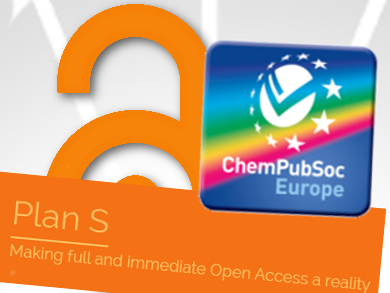ChemPubSoc Europe, the publishing body of 16 European chemical societies and owner of ChemViews Magazine on ChemistryViews.org, has submitted feedback to cOAlition S on their proposed implementation guidance for their open access (OA) publishing plan, Plan S, on February 8, 2019. It supports some of the principles but also has serious concerns about others.
What is Plan S
The idea of Plan S is to accelerate a shift from subscription-based journal models and embargo green open access to gold open access. Plan S has been published in September 2018 by a group of public and private research funders from 12 European countries who refer to themselves as cOAlition S. Plan S defines the framework for a transition to open access publishing by 2020 for research results funded by the involved organizations.
Publishing an article gold open access means the author or a sponsor pays an article publication charge (APC) to an open access journal and the article is immediately freely available online for all to read, download, share, and reuse. In contrast, green open access means the author publishes his/her article in any journal and then self-archives a version of the subscription article in a freely accessible institutional or specialist online archive known as a repository, or on a website after an embargo period.
cOAlition S demands that the publication of research funded by them is only permitted in Plan S-compliant open access journals or on Plan S-compliant open access platforms. Publication in hybrid journals is not considered compliant. Hybrid journals are subscription-based journals that allow authors to make individual articles gold open access immediately on payment of an article publication charge (APC). These are currently about 85 % of all journals. This gives authors the chance to publish their work open access in a journal they have been publishing in for years or that their peers read.
ChemPubSoc Europe’s Plan S Pros and Cons
ChemPubSoc Europe publishes 15 high-quality hybrid or gold OA journals. The 16 partnering societies benefit financially from these journals. ChemPubSoc Europe has a total of 70,000 members throughout Europe.
ChemPubSoc Europe supports the fundamental intention of Plan S. It welcomes the plan to create high-quality OA journals in fields where adequate platforms and infrastructures have not been available so far. It welcomes the plan that not individual authors, but funders and scientific institutions should pay the OA fees and that every author should be financially able to publish his or her work OA. However, they criticize that Plan S does not specify how this is to be ensured.
Especially scientists from low-income countries in Europe, who consider it unlikely that national grant agencies will make money available to them to cover OA fees, fear that this could push them towards publishing in journals not widely read by their peers.
ChemPubSoc Europe criticizes the decision that preprint servers are not Plan S-compliant. ChemRxiv, for example, the preprint server co-owned and collaboratively managed by the American Chemical Society (ACS), the German Chemical Society (GDCh), and the Royal Society of Chemistry (RSC), allows authors to make their manuscripts publicly available before publication in a journal at no additional cost.
As mentioned before, hybrid journals are regarded as non-Plan S-compliant. ChemPubSoc Europe considers this particularly critical and thinks that this will have serious negative effects on authors, readers, and societies. Many hybrid journals are among those with the highest impact factors in chemistry and are owned by nonprofit chemical societies. Examples are the Angewandte Chemie of the GDCh, the Journal of the American Chemical Society of the ACS, Chemistry – A European Journal of ChemPubSoc Europe, and Chemical Communications of the RSC.
The proposed standardization and capping of OA fees discriminates against high-quality journals that heavily select which articles they publish and favors average or mediocre quality journals with low rejection rates. ChemPubSoc Europe warns that this might increase the number of so-called predatory journals that publish everything. In chemistry, the journals with the highest impact factors and, thus, the highest rejection rate belong to chemical societies. ChemPubSoc Europe, therefore, fears that they will be hit disproportionately hard.
Research-intensive regions such as Asia and America have not declared their intention to participate in Plan S. The consequences and risks for research and researchers in Europe must be clearly assessed to rule out global disadvantages.
ChemPubSoc Europe appreciates the freedom of the scientist and sees the exclusion of hybrid OA journals and the obligation to publish under the most liberal OA license (CC-BY) that maximizes reuse, including for commercial purposes, as restrictions of this freedom.
Access to Research Publications without Damaging Science
ChemPubSoc Europe hopes cOAlition S will incorporate their concerns into future considerations and implementation plans. “The legitimate aim of making scientific results freely accessible to all must not be thwarted by unintended, science-damaging consequences.”, they say.
Like ChemPubSoc Europe, many chemical societies, publishers, funding agencies, libraries, and other stakeholders also have submitted feedback to COAlition S and share very similar opinions. Deadline for submission was February 8, 2019. cOAlition S said that they will share the feedback received publicly.
Also of Interest
- Statement of ChemPubSoc Europe on Plan S,
- Statement of the German Chemical Society on Plan S,
German Chemical Society (GDCh; Gesellschaft Deutscher Chemiker), Frankfurt, Germany
- Wiley and Projekt DEAL Partnership Pilots New Publishing Models,
ChemViews Mag. January 2019.
Wiley and Projekt DEAL partner to enhance the future of scholarly research and publishing in Germany
- American Chemical Society Responds to Plan S
- Royal Society of Chemistry policy position statement on Plan S
- SAGE Publishing Statement on Plan S
- Plan S Implementation Guidance: Submission From Springer Nature
- Taylor & Francis Group: Feedback on Guidance on the Implementation of Plan S
- Wiley Response to Coalition S on Plan S




